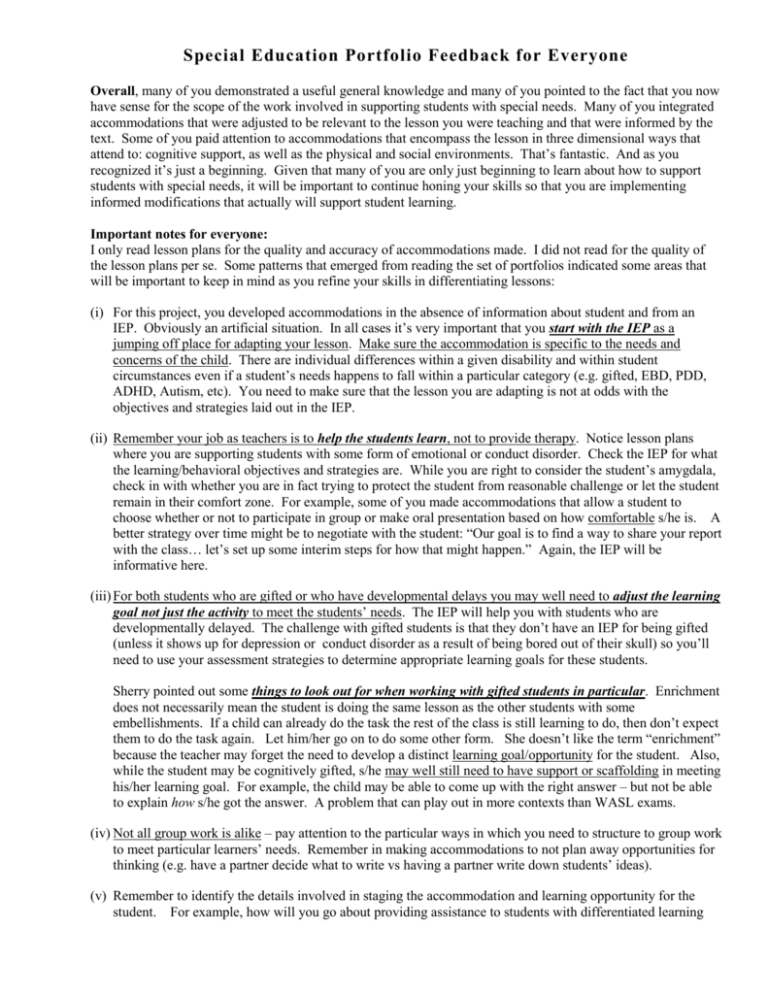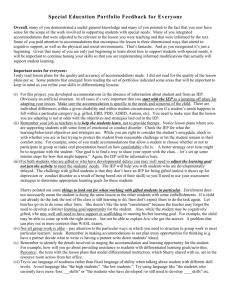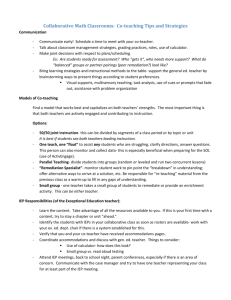spedk
advertisement

Special Education Portfolio Feedback for Everyone Overall, many of you demonstrated a useful general knowledge and many of you pointed to the fact that you now have sense for the scope of the work involved in supporting students with special needs. Many of you integrated accommodations that were adjusted to be relevant to the lesson you were teaching and that were informed by the text. Some of you paid attention to accommodations that encompass the lesson in three dimensional ways that attend to: cognitive support, as well as the physical and social environments. That’s fantastic. And as you recognized it’s just a beginning. Given that many of you are only just beginning to learn about how to support students with special needs, it will be important to continue honing your skills so that you are implementing informed modifications that actually will support student learning. Important notes for everyone: I only read lesson plans for the quality and accuracy of accommodations made. I did not read for the quality of the lesson plans per se. Some patterns that emerged from reading the set of portfolios indicated some areas that will be important to keep in mind as you refine your skills in differentiating lessons: (i) For this project, you developed accommodations in the absence of information about student and from an IEP. Obviously an artificial situation. In all cases it’s very important that you start with the IEP as a jumping off place for adapting your lesson. Make sure the accommodation is specific to the needs and concerns of the child. There are individual differences within a given disability and within student circumstances even if a student’s needs happens to fall within a particular category (e.g. gifted, EBD, PDD, ADHD, Autism, etc). You need to make sure that the lesson you are adapting is not at odds with the objectives and strategies laid out in the IEP. (ii) Remember your job as teachers is to help the students learn, not to provide therapy. Notice lesson plans where you are supporting students with some form of emotional or conduct disorder. Check the IEP for what the learning/behavioral objectives and strategies are. While you are right to consider the student’s amygdala, check in with whether you are in fact trying to protect the student from reasonable challenge or let the student remain in their comfort zone. For example, some of you made accommodations that allow a student to choose whether or not to participate in group or make oral presentation based on how comfortable s/he is. A better strategy over time might be to negotiate with the student: “Our goal is to find a way to share your report with the class… let’s set up some interim steps for how that might happen.” Again, the IEP will be informative here. (iii) For both students who are gifted or who have developmental delays you may well need to adjust the learning goal not just the activity to meet the students’ needs. The IEP will help you with students who are developmentally delayed. The challenge with gifted students is that they don’t have an IEP for being gifted (unless it shows up for depression or conduct disorder as a result of being bored out of their skull) so you’ll need to use your assessment strategies to determine appropriate learning goals for these students. Sherry pointed out some things to look out for when working with gifted students in particular. Enrichment does not necessarily mean the student is doing the same lesson as the other students with some embellishments. If a child can already do the task the rest of the class is still learning to do, then don’t expect them to do the task again. Let him/her go on to do some other form. She doesn’t like the term “enrichment” because the teacher may forget the need to develop a distinct learning goal/opportunity for the student. Also, while the student may be cognitively gifted, s/he may well still need to have support or scaffolding in meeting his/her learning goal. For example, the child may be able to come up with the right answer – but not be able to explain how s/he got the answer. A problem that can play out in more contexts than WASL exams. (iv) Not all group work is alike – pay attention to the particular ways in which you need to structure to group work to meet particular learners’ needs. Remember in making accommodations to not plan away opportunities for thinking (e.g. have a partner decide what to write vs having a partner write down students’ ideas). (v) Remember to identify the details involved in staging the accommodation and learning opportunity for the student. For example, how will you go about providing assistance to students with differentiated learning goals/activities. Resource: the texts with the lesson plans that model differentiated instruction, which Sherry shared with us, are in the resource room across from her office. (vi) Try to use language of readiness rather than fixed language of ability when talking about student with different skill levels. Avoid language like “the high students” “the low students.” Try using language like “the students who currently have more /less ___skills” or “the students who have developed /or still need to develop ____skills” etc. … and for K S Checklist of necessary components Annotation of 3 children's and adolescent books that address a disability or someone with the disability: √ for elementary student √ or middle or high school students. Annotations include: √ Brief summary of the story-line In progress Critique of the content, both positive and problematic. You need to address any ethnic, gender, class, and disability stereotypes, at a minimum. You could also address out-of-date information, quality of illustrations, etc. √ The age level for whom the book is appropriate. √ A short list of ideas how the book could be used in your curriculum. Annotation & review of 5 (total) web-sites √ a brief description of the site Could elaborate a critique of its usefulness. 5 lessons plans differentiated: √ specific strategies identified in text NA If used “more capable peer” or “small/cooperative groups” as accommodations, identified and explained the specific strategies to be used in these situations. Feedback Succinct descriptions of books. You begin to turn a critical eye toward the stories (e.g. Natalie as purely autistic vs. as person with other qualities). You identify some interesting ways of integrating these stories into your classroom. You found some interesting sites and provided succinct descriptions of what kinds of resources they contain and who the site is directed towards. Here a places to turn more of a discerning eye: what might be some problems with the sites: e.g. Vested interests, accuracy of information, etc. You identified some interesting accommodations, some of which are informed by the guidelines in text and that address the kinds of needs students with particular disabilities have. Make sure you are attending to what the specific issue is for the student (e.g. what is the student struggling with in reading?) Make sure that you are paying attention to what distinguishes disabilities (e.g. language and speech disorders are different). The accommodations need to fit the specific issue the student has.






